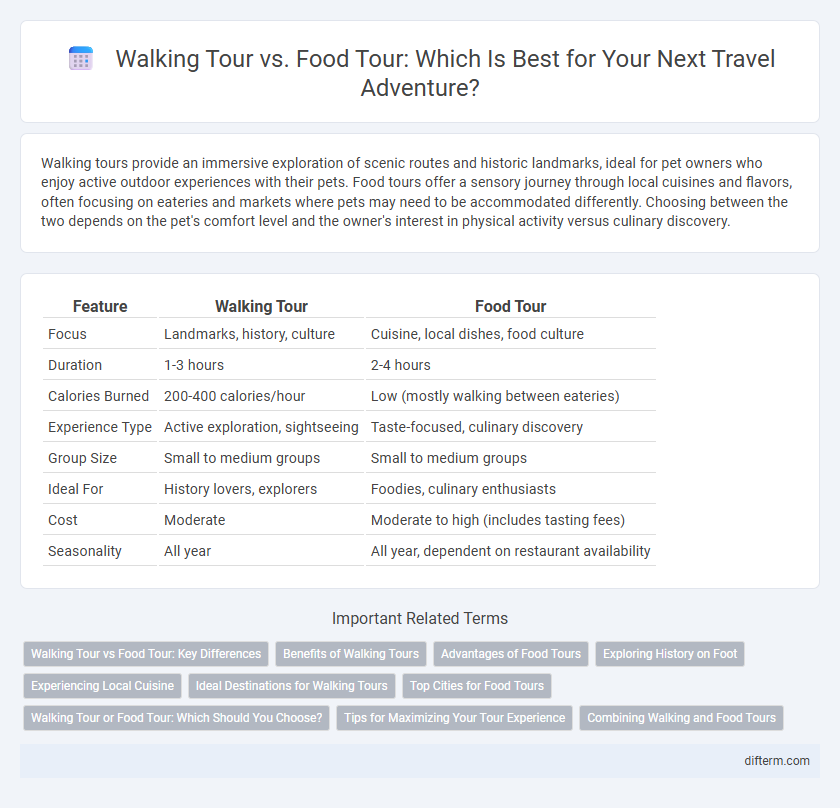Walking tours provide an immersive exploration of scenic routes and historic landmarks, ideal for pet owners who enjoy active outdoor experiences with their pets. Food tours offer a sensory journey through local cuisines and flavors, often focusing on eateries and markets where pets may need to be accommodated differently. Choosing between the two depends on the pet's comfort level and the owner's interest in physical activity versus culinary discovery.
Table of Comparison
| Feature | Walking Tour | Food Tour |
|---|---|---|
| Focus | Landmarks, history, culture | Cuisine, local dishes, food culture |
| Duration | 1-3 hours | 2-4 hours |
| Calories Burned | 200-400 calories/hour | Low (mostly walking between eateries) |
| Experience Type | Active exploration, sightseeing | Taste-focused, culinary discovery |
| Group Size | Small to medium groups | Small to medium groups |
| Ideal For | History lovers, explorers | Foodies, culinary enthusiasts |
| Cost | Moderate | Moderate to high (includes tasting fees) |
| Seasonality | All year | All year, dependent on restaurant availability |
Walking Tour vs Food Tour: Key Differences
Walking tours offer an immersive exploration of a city's landmarks, culture, and history through guided routes, while food tours prioritize sampling local cuisines and culinary traditions at multiple eateries. Walking tours emphasize physical activity and sightseeing, providing extensive knowledge about architectural and historical sites, whereas food tours focus on sensory experiences and tasting sessions to highlight regional flavors. Both tours facilitate discovery but differ in their primary engagement--walking tours in cultural education and food tours in gastronomic enjoyment.
Benefits of Walking Tours
Walking tours offer an immersive way to explore a destination's culture, architecture, and history while promoting physical activity and well-being. These tours provide flexibility to visit hidden gems inaccessible by vehicles, enhancing the sense of discovery. Participants often experience local life firsthand, gaining deeper connections with the environment and community compared to food tours.
Advantages of Food Tours
Food tours offer an immersive cultural experience by allowing travelers to sample authentic local cuisine and discover hidden dining gems often missed on walking tours. These tours provide expert-guided tastings combined with historical insights about regional dishes, enhancing both culinary knowledge and cultural appreciation. Participants gain a sensory-rich adventure that supports local food artisans and creates lasting memories beyond typical sightseeing.
Exploring History on Foot
Walking tours immerse travelers in local history by navigating authentic neighborhoods and landmarks on foot, allowing an intimate exploration of cultural heritage and architectural details. Food tours offer a sensory journey through regional cuisine, connecting historical narratives to culinary traditions rooted in the area's development. Combining both experiences enriches understanding of history through tangible tastes and contextual storytelling.
Experiencing Local Cuisine
Walking tours offer immersive exploration of a city's culture and landmarks while providing opportunities to taste street food and local snacks at authentic vendors. Food tours focus primarily on sampling a curated selection of regional dishes, often guided by culinary experts who share insights into traditional recipes and food history. Both experiences enrich travelers' understanding and enjoyment of local cuisine, with walking tours emphasizing broader cultural context and food tours delivering deep gastronomic knowledge.
Ideal Destinations for Walking Tours
Ideal destinations for walking tours include cities with rich historical architecture, vibrant street life, and accessible pedestrian paths, such as Rome, Kyoto, and Barcelona. These locations offer immersive experiences through cobblestone streets, cultural landmarks, and scenic neighborhoods, perfect for travelers seeking exploration by foot. Walking tours provide an intimate understanding of a city's character, allowing visitors to discover hidden gems and local stories often missed on food tours.
Top Cities for Food Tours
Top cities for food tours include Tokyo, known for its diverse street food and sushi experiences, and Barcelona, where tapas and local Catalan cuisine dominate walking routes. New Orleans offers rich Creole flavors coupled with historical walking tours, providing a sensory adventure through its vibrant neighborhoods. On the other hand, walking tours in cities like Paris emphasize architectural landmarks and cultural sites, often with less focus on culinary exploration.
Walking Tour or Food Tour: Which Should You Choose?
Walking tours offer immersive exploration of city landmarks and hidden gems through guided narratives and scenic routes, ideal for history and culture enthusiasts. Food tours focus on tasting local cuisine, providing a sensory experience of regional flavors and culinary traditions, perfect for food lovers wanting to sample authentic dishes. Choosing between a walking tour and a food tour depends on your interests: opt for a walking tour if you seek cultural insights and exploration, or a food tour if you prioritize culinary discovery.
Tips for Maximizing Your Tour Experience
Choose a walking tour in vibrant city neighborhoods to fully immerse yourself in local culture and historic architecture, enhancing sensory engagement beyond just taste. Opt for food tours that offer small, varied portions to sample diverse flavors while avoiding fullness that limits exploration. Plan routes strategically to balance activity and dining, wear comfortable shoes, stay hydrated, and engage with guides to uncover hidden gems and authentic stories.
Combining Walking and Food Tours
Combining walking tours and food tours offers a rich, immersive travel experience by allowing travelers to explore cultural landmarks on foot while savoring local cuisine at authentic eateries. This integrated approach enhances sensory engagement, blending physical activity with culinary discovery to deepen appreciation of a destination's heritage and flavors. Tour operators increasingly design hybrid itineraries that maximize time efficiency and provide a holistic understanding of both the geography and gastronomy of travel locations.
Walking Tour vs Food Tour Infographic

 difterm.com
difterm.com